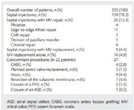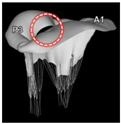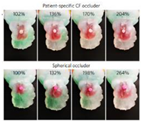A Systematic Review of Individualized Heart Surgery with a Personalized Prosthesis
Abstract
:1. Introduction
2. Materials and Methods
2.1. Search Strategy
2.2. Inclusion Criteria and Exclusion Criteria
2.3. Study Selection and Outcome of Interest
2.4. Quality of Evidence and Risk of Bias Assessment
3. Results
3.1. Quantity of Evidence
3.2. Included Studies Characteristics
3.3. Summary of the Intervention
3.4. Outcomes and Interest Variables
4. Discussion
4.1. Limitations
4.2. Future Directions
5. Conclusions
Supplementary Materials
Author Contributions
Funding
Institutional Review Board Statement
Informed Consent Statement
Data Availability Statement
Conflicts of Interest
References
- Boland, G.M.; Meric-Bernstam, F. The role of surgeons in building a personalized medicine program. J. Surg. Oncol. 2015, 111, 3–8. [Google Scholar] [CrossRef]
- Lopez-Perez, A.; Sebastian, R.; Ferrero, J.M. Three-dimensional cardiac computational modelling: Methods, features and applications. Biomed. Eng. Online 2015, 14, 35. [Google Scholar] [CrossRef] [PubMed]
- Wang, D.D.; Qian, Z.; Vukicevic, M.; Engelhardt, S.; Kheradvar, A.; Zhang, C.; Little, S.H.; Verjans, J.; Comaniciu, D.; O’Neill, W.W.; et al. 3D Printing, Computational Modeling, and Artificial Intelligence for Structural Heart Disease. JACC Cardiovasc. Imaging 2021, 14, 41–60. [Google Scholar] [CrossRef]
- Nan, J.; Rezaei, M.; Mazhar, R.; Jaber, F.; Musharavati, F.; Zalnezhad, E.; Chowdhury, M.E.H. Finite Element Analysis of the Mechanism of Traumatic Aortic Rupture (TAR). Comput. Math. Methods Med. 2020, 2020, 6718495. [Google Scholar] [CrossRef] [PubMed]
- Duraiswamy, N.; Weaver, J.D.; Ekrami, Y.; Retta, S.M.; Wu, C. A Parametric Computational Study of the Impact of Non-circular Configurations on Bioprosthetic Heart Valve Leaflet Deformations and Stresses: Possible Implications for Transcatheter Heart Valves. Cardiovasc. Eng. Technol. 2016, 7, 126–138. [Google Scholar] [CrossRef]
- Archbold, A.; Akowuah, E.; Banning, A.P.; Baumbach, A.; Braidley, P.; Cooper, G.; Kendall, S.; MacCarthy, P.; O’Kane, P.; O’Keeffe, N.; et al. Getting the best from the Heart Team: Guidance for cardiac multidisciplinary meetings. Heart (Br. Card. Soc.) 2022, 108, e2. [Google Scholar] [CrossRef] [PubMed]
- Pragt, H.; Pieper, P.G.; van Slooten, Y.J.; Freling, H.G.; van Dijk, A.P.J.; Sieswerda, G.T.J.; Bouma, B.J.; Post, M.C.; Jongbloed, M.R.M.; Willems, T.P.; et al. Quality of Life Among Patients with Congenital Heart Disease After Valve Replacement. Semin. Thorac. Cardiovasc. Surg. 2019, 31, 549–558. [Google Scholar] [CrossRef] [PubMed]
- Matsumoto, K.; Hisashi, Y.; Imoto, Y. Replacement of the heavily calcified ascending aorta in aortic valve replacement. Asian Cardiovasc. Thorac. Ann. 2015, 23, 349–352. [Google Scholar] [CrossRef] [PubMed]
- Mahesh, B.; Wells, F.; Nashef, S.; Nair, S. Role of concomitant tricuspid surgery in moderate functional tricuspid regurgitation in patients undergoing left heart valve surgery. Eur. J. Cardio-Thorac. Surg. Off. J. Eur. Assoc. Cardio-Thorac. Surg. 2013, 43, 2–8. [Google Scholar] [CrossRef] [PubMed]
- Mrsic, Z.; Hopkins, S.P.; Antevil, J.L.; Mullenix, P.S. Valvular Heart Disease. Prim. Care 2018, 45, 81–94. [Google Scholar] [CrossRef] [PubMed]
- Hollenberg, S.M. Valvular Heart Disease in Adults: Etiologies, Classification, and Diagnosis. FP Essent. 2017, 457, 11–16. [Google Scholar] [PubMed]
- Gopal, S.; Hauser, J.M.; Mahboobi, S.K. Mechanical Aortic Valve Replacement. In StatPearls; StatPearls Publishing: Treasure Island, FL, USA, 2021. [Google Scholar]
- Bykowski, A.; Perez, O.A.; Kanmanthareddy, A. Balloon Valvuloplasty. In StatPearls; StatPearls Publishing: Treasure Island, FL, USA, 2021. [Google Scholar]
- Ler, A.; Ying, Y.J.; Sazzad, F.; Choong, A.M.T.L.; Kofidis, T. Structural durability of early-generation Transcatheter aortic valve replacement valves compared with surgical aortic valve replacement valves in heart valve surgery: A systematic review and meta-analysis. J. Cardiothorac. Surg. 2020, 15, 127. [Google Scholar] [CrossRef]
- Nickenig, G.; Weber, M.; Schüler, R.; Hausleiter, J.; Nabauer, M.; von Bardeleben, R.S.; Sotiriou, E.; Schäfer, U.; Deuschl, F.; Alessandrini, H.; et al. Tricuspid valve repair with the Cardioband system: Two-year outcomes of the multicentre, prospective TRI-REPAIR study. EuroIntervention J. EuroPCR Collab. Work. Group Interv. Cardiol. Eur. Soc. Cardiol. 2021, 16, e1264–e1271. [Google Scholar] [CrossRef] [PubMed]
- Price, M.J. Transcatheter Mitral Valve Repair and Replacement: New Standards of Care and New Horizons for Therapy. Interv. Cardiol. Clin. 2019, 8, xi–xii. [Google Scholar] [CrossRef] [PubMed]
- Grégoire, C.; Nellessen, E.; Defraigne, J.O.; Radermecker, M.A. La prothèse valvulaire idéale n’existe toujours pas. quels facteurs entrent en compte pour orienter les choix d’une valve mécanique ou biologique? Rev. Med. Liege. 2014, 69, 600–604. (In French) [Google Scholar]
- Damle, S.; Thourani, V.H. Surgical Valve Prosthesis Choices: Choose for the Now, But Don’t Forget About the Future. Ann. Thorac. Surg. 2021, 111, 1206. [Google Scholar] [CrossRef] [PubMed]
- Kim, W.; Choi, H.; Kweon, J.; Yang, D.H.; Kim, Y.H. Effects of pannus formation on the flow around a bileaflet mechanical heart valve. PLoS ONE 2020, 15, e0234341. [Google Scholar] [CrossRef] [PubMed]
- Luthra, S.; Malvindi, P.G.; Olevano, C.; Zingale, A.; Salem, H.; Ohri, S.K. Impact of valve size, predicted effective and indexed effective orifice area after aortic valve replacement. J. Card. Surg. 2021, 36, 961–968. [Google Scholar] [CrossRef]
- Dumesnil, J.G.; Pibarot, P. Prosthesis-patient mismatch: An update. Curr. Cardiol. Rep. 2011, 13, 250–257. [Google Scholar] [CrossRef] [PubMed]
- Salna, M.; Khalique, O.K.; Chiuzan, C.; Kurlansky, P.; Borger, M.A.; Hahn, R.T.; Leon, M.B.; Smith, C.R.; Kodali, S.K.; George, I. Impact of small prosthesis size on transcatheter or surgical aortic valve replacement outcomes. Catheter. Cardiovasc. Interv. Off. J. Soc. Card. Angiogr. Interv. 2018, 91, 765–773. [Google Scholar] [CrossRef] [PubMed]
- Ali, N.F.; Mahadevan, V.S.; Muir, A.; Maguire, C.; Young, D.; Campalani, G.; Campbell, N.P.; Danton, M.H. The influence of prosthesis size and design on exercise dynamics after aortic valve replacement. J. Heart Valve Dis. 2006, 15, 755–762. [Google Scholar] [PubMed]
- Hagenah, J.; Werrmann, E.; Scharfschwerdt, M.; Ernst, F.; Metzner, C. Prediction of individual prosthesis size for valve-sparing aortic root reconstruction based on geometric features. In Proceedings of the Annual International Conference of the IEEE Engineering in Medicine and Biology Society, Orlando, FL, USA, 16–20 August 2016; Annual International Conference. Volume 2016, pp. 3273–3276. [Google Scholar] [CrossRef]
- Hori, D.; Kusadokoro, S.; Shimizu, T.; Kimura, N.; Yamaguchi, A. Prosthetic Graft Dilation at the Aortic Arch in the Era of Hybrid Aortic Surgery. Ann. Vasc. Dis. 2020, 13, 163–169. [Google Scholar] [CrossRef] [PubMed]
- Moher, D.; Liberati, A.; Tetzlaff, J.; Altman, D.G.; PRISMA Group. Preferred reporting items for systematic reviews and meta-analyses: The PRISMA statement. PLoS Med. 2009, 6, e1000097. [Google Scholar] [CrossRef]
- Endnote, X9; Reference Management Software; Clarivate Analytics: Philadelphia, PA, USA, 2021. Available online: https://endnote.com/product-details(accessed on 15 August 2023).
- Schünemann, H.J.; Higgins, J.P.T.; Vist, G.E.; Glasziou, P.; Akl, E.A.; Skoetz, N.; Guyatt, G.H.; (on behalf of the Cochrane GRADEing Methods Group and the Cochrane Statistical Methods Group). Cochrane Handbook for Systematic Reviews of Interventions Version 6.0 (Updated July 2019); Cochrane: London, UK, 2019; Available online: https://training.cochrane.org/handbook/current/chapter-14 (accessed on 15 August 2023).
- Review Manager (RevMan) [Computer Program], Version 5.4; The Nordic Cochrane Centre, The Cochrane Collaboration: Copenhagen, Denmark, 2014. Available online: https://training.cochrane.org/online-learning/core-software/revman(accessed on 15 August 2023).
- Amerini, A.; Hatam, N.; Malasa, M.; Pott, D.; Tewarie, L.; Isfort, P.; Goetzenich, A.; Hildinger, M.; Autschbach, R.; Spillner, J. A personalized approach to interventional treatment of tricuspid regurgitation: Experiences from an acute animal study. Interact. Cardiovasc. Thorac. Surg. 2014, 19, 414–418. [Google Scholar] [CrossRef] [PubMed]
- Collis, R.; Tsang, V.; Pantazis, A.; Tome-Esteban, M.; Elliott, P.M.; McGregor, C.G.A. Individualized surgical strategies for left ventricular outflow tract obstruction in hypertrophic cardiomyopathy. Eur. J. Cardio-Thorac. Surg. Off. J. Eur. Assoc. Cardio-Thorac. Surg. 2018, 53, 1237–1243. [Google Scholar] [CrossRef] [PubMed]
- Ovcharenko, E.A.; Klyshnikov, K.U.; Yuzhalin, A.E.; Savrasov, G.V.; Kokov, A.N.; Batranin, A.V.; Ganyukov, V.I.; Kudryavtseva, Y.A. Modeling of transcatheter aortic valve replacement: Patient specific vs general approaches based on finite element analysis. Comput. Biol. Med. 2016, 69, 29–36. [Google Scholar] [CrossRef] [PubMed]
- Pasta, S.; Cannata, S.; Gentile, G.; Di Giuseppe, M.; Cosentino, F.; Pasta, F.; Agnese, V.; Bellavia, D.; Raffa, G.M.; Pilato, M.; et al. Simulation study of transcatheter heart valve implantation in patients with stenotic bicuspid aortic valve. Med. Biol. Eng. Comput. 2020, 58, 815–829. [Google Scholar] [CrossRef] [PubMed]
- Rim, Y.; Choi, A.; McPherson, D.D.; Kim, H. Personalized Computational Modeling of Mitral Valve Prolapse: Virtual Leaflet Resection. PLoS ONE 2015, 10, e0130906. [Google Scholar] [CrossRef]
- Robinson, S.S.; Alaie, S.; Sidoti, H.; Auge, J.; Baskaran, L.; Avilés-Fernández, K.; Hollenberg, S.D.; Shepherd, R.F.; Min, J.K.; Dunham, S.N.; et al. Patient-specific design of a soft occluder for the left atrial appendage. Nat. Biomed. Eng. 2018, 2, 8–16. [Google Scholar] [CrossRef]
- Yuan, D.; Luo, H.; Yang, H.; Huang, B.; Zhu, J.; Zhao, J. Precise treatment of aortic aneurysm by three-dimensional printing and simulation before endovascular intervention. Sci. Rep. 2017, 7, 795. [Google Scholar] [CrossRef]
- Mathew, P.; Kanmanthareddy, A. Prosthetic Heart Valve. In StatPearls; StatPearls Publishing: Treasure Island, FL, USA, 2021. Available online: https://www.ncbi.nlm.nih.gov/books/NBK536987/ (accessed on 15 August 2023).
- Alkadhi, H.; Euler, A. The Future of Computed Tomography: Personalized, Functional, and Precise. Investig. Radiol. 2020, 55, 545–555. [Google Scholar] [CrossRef] [PubMed]
- Kong, F.; Caballero, A.; McKay, R.; Sun, W. Finite element analysis of MitraClip procedure on a patient-specific model with functional mitral regurgitation. J. Biomech. 2020, 104, 109730. [Google Scholar] [CrossRef] [PubMed]
- Pham, T.; Kong, F.; Martin, C.; Wang, Q.; Primiano, C.; McKay, R.; Elefteriades, J.; Sun, W. Finite Element Analysis of Patient-Specific Mitral Valve with Mitral Regurgitation. Cardiovasc. Eng. Technol. 2017, 8, 3–16. [Google Scholar] [CrossRef] [PubMed]
- Kong, F.; Pham, T.; Martin, C.; Elefteriades, J.; McKay, R.; Primiano, C.; Sun, W. Finite element analysis of annuloplasty and papillary muscle relocation on a patient-specific mitral regurgitation model. PLoS ONE 2018, 13, e0198331. [Google Scholar] [CrossRef]
- Kato, B.; Wisser, G.; Agrawal, D.K.; Wood, T.; Thankam, F.G. 3D bioprinting of cardiac tissue: Current challenges and perspectives. Journal of materials science. Mater. Med. 2021, 32, 54. [Google Scholar] [CrossRef]
- Sazzad, F.; Goh, J.H.; Ong, Z.X.; Almsherqi, Z.A.M.; Lakshminarasappa, S.R.; Ramanathan, K.R.; Kofidis, T. Three dimensional modeling of atrioventricular valves provides predictive guides for optimal choice of prosthesis. Sci. Rep. 2022, 12, 7432. [Google Scholar] [CrossRef] [PubMed]
- Nappi, F.; Spadaccio, C.; Mihos, C.G.; Fraldi, M. Biomechanics raises solution to avoid geometric mitral valve configuration abnormalities in ischemic mitral regurgitation. J. Thorac. Dis. 2017, 9 (Suppl. 7), S624–S628. [Google Scholar] [CrossRef] [PubMed]

| Author, Year | Amerini et al., 2014 [30] | Collis et al., 2018 [31] | Ovcharenko et al., 2016 [32] | Pasta et al., 2020 [33] | Rim et al., 2015 [34] | Robinson et al., 2018 [35] | Yuan et al., 2017 [36] |
|---|---|---|---|---|---|---|---|
| Journal | ICVTS | EJCTS | CBM | MBEC | PLOS 1 | NBE | SRS |
| Place | Germany | UK | Russia | Italy | Texas | New York | China |
| N | 12 | 203 | 1 | 9 | 1 | 1 | 2 |
| Species | Pigs | Patients | Patients | Patients | Patients | Canine | Patients |
| Study type | Experimental | Clinical trial | Case report | Case series | Case report | Experimental | Case reports |
| Target site | Tricuspid valve | LVOT | Aortic valve | BAV | Mitral valve | LAA | Aorta |
| Method | CT scan | Echo | CT scan | CT scan | TEE, FEA | 3D TEE | CT scan |
| Prototyping | In silico | Clinical | FEA | Rhino CAD | FEA | SolidWorks CAD | MIMIC 16.0 |
| Postprocessing | RA geometry | HCM | 3D modeling | Aortic valve | MVs | LA occlusion | 3Dp model |
| Intervention | Catheter guided | Surgery | TAVR | TAVI | Virtual repair | Guided surgery | Simulation Surgery |
| Reconstruction | 3D | NA | 3D | ICEM-CFD | Virtual MV | 3D | 3D |
| Model | Solid alumide | Surgical technique | Nitinol model | Cobalt-chromium | Dynamic FEA | Silicone | TADA 3D printed |
| Device | TTVI | NA | CoreValve | SAPIEN 3 | Mitral valve leaflet | LAA occlude | Chimney stents |
| Positioning | Surgical | Surgical | Transcatheter | Transcatheter | Virtual | Surgical | Transcatheter |
| Evaluation | CT scan | Echo | CT scan | CT scan and TEE | Dynamic FEA | 3D TEE | Angiography |
| Autopsy | All cases | - | - | - | - | After 24 h | - |
| Journal | ICVTS | EJCTS | CBM | MBEC | PLOS 1 | NBE | SRS |
| Relevant image |  |  |  |  |  |  |  |
Disclaimer/Publisher’s Note: The statements, opinions and data contained in all publications are solely those of the individual author(s) and contributor(s) and not of MDPI and/or the editor(s). MDPI and/or the editor(s) disclaim responsibility for any injury to people or property resulting from any ideas, methods, instructions or products referred to in the content. |
© 2023 by the authors. Licensee MDPI, Basel, Switzerland. This article is an open access article distributed under the terms and conditions of the Creative Commons Attribution (CC BY) license (https://creativecommons.org/licenses/by/4.0/).
Share and Cite
Sazzad, F.; Ramanathan, K.; Moideen, I.S.; Gohary, A.E.; Stevens, J.C.; Kofidis, T. A Systematic Review of Individualized Heart Surgery with a Personalized Prosthesis. J. Pers. Med. 2023, 13, 1483. https://doi.org/10.3390/jpm13101483
Sazzad F, Ramanathan K, Moideen IS, Gohary AE, Stevens JC, Kofidis T. A Systematic Review of Individualized Heart Surgery with a Personalized Prosthesis. Journal of Personalized Medicine. 2023; 13(10):1483. https://doi.org/10.3390/jpm13101483
Chicago/Turabian StyleSazzad, Faizus, Kollengode Ramanathan, Irwan Shah Moideen, Abdulrahman El Gohary, John Carey Stevens, and Theo Kofidis. 2023. "A Systematic Review of Individualized Heart Surgery with a Personalized Prosthesis" Journal of Personalized Medicine 13, no. 10: 1483. https://doi.org/10.3390/jpm13101483







